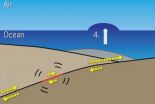(Press-News.org) The magnitude 9 earthquake and resulting tsunami that struck Japan on March 11 were like a one-two punch – first violently shaking, then swamping the islands – causing tens of thousands of deaths and hundreds of billions of dollars in damage. Now Stanford researchers have discovered the catastrophe was caused by a sequence of unusual geologic events never before seen so clearly.
"It was not appreciated before this earthquake that this size of earthquake was possible on this plate boundary," said Stanford geophysicist Greg Beroza. "It was thought that typical earthquakes were much smaller."
The earthquake occurred in a subduction zone, where one great tectonic plate is being forced down under another tectonic plate and into the Earth's interior along an active fault.
The fault on which the Tohoku-Oki earthquake took place slopes down from the ocean floor toward the west. It first ruptured mainly westward from its epicenter – 32 kilometers (about 20 miles) below the seafloor – toward Japan, shaking the island of Honshu violently for 40 seconds.
Surprisingly, the fault then ruptured eastward from the epicenter, up toward the ocean floor along the sloping fault plane for about 30 or 35 seconds.
As the rupture neared the seafloor, the movement of the fault grew rapidly, violently deforming the seafloor sediments sitting on top of the fault plane, punching the overlying water upward and triggering the tsunami.
"When the rupture approached the seafloor, it exploded into tremendously large slip," said Beroza. "It displaced the seafloor dramatically.
"This amplification of slip near the surface was predicted in computer simulations of earthquake rupture, but this is the first time we have clearly seen it occur in a real earthquake.
"The depth of the water column there is also greater than elsewhere," Beroza said. "That, together with the slip being greatest where the fault meets the ocean floor, led to the tsunami being outlandishly big."
Beroza is one of the authors of a paper detailing the research, published online last week in Science Express.
"Now that this slip amplification has been observed in the Tohoku-Oki earthquake, what we need to figure out is whether similar earthquakes – and large tsunamis – could happen in other subduction zones around the world," he said.
Beroza said the sort of "two-faced" rupture seen in the Tohoku-Oki earthquake has not been seen in other subduction zones, but that could be a function of the limited amount of data available for analyzing other earthquakes.
There is a denser network of seismometers in Japan than any other place in the world, he said. The sensors provided researchers with much more detailed data than is normally available after an earthquake, enabling them to discern the different phases of the March 11 temblor with much greater resolution than usual.
Prior to the Tohoku-Oki earthquake, Beroza and Shuo Ma, who is now an assistant professor at San Diego State University, had been working on computer simulations of what might happen during an earthquake in just such a setting. Their simulations had generated similar "overshoot" of sediments overlying the upper part of the fault plane.
Following the Japanese earthquake, aftershocks as large as magnitude 6.5 slipped in the opposite direction to the main shock. This is a symptom of what is called "extreme dynamic overshoot" of the upper fault plane, Beroza said, with the overextended sediments on top of the fault plane slipping during the aftershocks back in the direction they came from.
"We didn't really expect this to happen because we believe there is friction acting on the fault" that would prevent any rebound, he said. "Our interpretation is that it slipped so much that it sort of overdid it. And in adjusting during the aftershock sequence, it went back a bit.
"We don't see these bizarre aftershocks on parts of the fault where the slip is less," he said.
The damage from the March 11 earthquake was so extensive in part simply because the earthquake was so large. But the way it ruptured on the fault plane, in two stages, made the devastation greater than it might have been otherwise, Beroza said.
The deeper part of the fault plane, which sloped downward to the west, was bounded by dense, hard rock on each side. The rock transmitted the seismic waves very efficiently, maximizing the amount of shaking felt on the island of Honshu.
The shallower part of the fault surface, which slopes upward to the east and surfaces at the Japan Trench – where the overlying plate is warped downward by the motion of the descending plate – had massive slip. Unfortunately, this slip was ideally situated to efficiently generate the gigantic tsunami, with devastating consequences.
INFORMATION:
Other coauthors of the Science Express paper are Annemarie Baltay, a graduate student in geophysics at Stanford, and Satoshi Ide, an associate professor of Earth and planetary science at the University of Tokyo.
Unusual earthquake gave Japan tsunami extra punch, say Stanford scientists
2011-05-24
ELSE PRESS RELEASES FROM THIS DATE:
Seeing an atomic thickness
2011-05-24
Scientists from the National Physical Laboratory (NPL), in collaboration with Linköping University, Sweden, have shown that regions of graphene of different thickness can be easily identified in ambient conditions using Electrostatic Force Microscopy (EFM).
The exciting properties of graphene are usually only applicable to the material that consists of one or two layers of the graphene sheets. Whilst synthesis of any number of layers is possible, the thicker layers have properties closer to the more common bulk graphite.
For device applications one- and two-layer graphene ...
Frequent moderate drinking of alcohol is associated with a lower risk of fatty liver disease
2011-05-24
In a large study of men in Japan, the presence of fatty liver disease by ultrasonography showed an inverse ( reduced risk) association with the frequency of moderate alcohol consumption; however, there was some suggestion of an increase in fatty liver disease with higher volume of alcohol consumed per day. Moderate drinkers had lower levels of obesity than did non-drinkers, and both obesity and metabolic abnormalities were positively associated with fatty liver disease.
These findings support the results of a number of other recent studies showing that moderate drinking ...
We have the technology for creating sustainable energy systems of the future
2011-05-24
We still need to halt the increase of global carbon emissions before 2020 and in the long term reduce emissions by at least 50% up to 2050. Ultimately, we will have to reduce carbon emissions to close to zero or even remove carbon completely from the atmosphere.
However, climate change is not the only energy challenge:
We need energy services to drive global economic development
We need to provide equal access to modern energy worldwide
We need to provide electricity to the 25% of the world's population still without electricity
We need to provide modern energy ...
Lifestyle counseling and glycemic control in patients with diabetes: True to form?
2011-05-24
Boston, MA – Electronic medical records (EMRs) have been in use for more than 30 years, but have only increased in utilization in recent years, due in part to research supporting the benefits of EMRs and federal legislation. As EMRs have become a standard in medical care, there is a need for additional research of how the system and usage can be refined. A group of researchers from Brigham and Women's Hospital have done just that, and discovered that one way false information can make its way into EMRs is due to users' reliance on copying and pasting material within the ...
Expert discovers simple method of dealing with harmful radioactive iodine
2011-05-24
A novel way to immobilise radioactive forms of iodine using a microwave, has been discovered by an expert at the University of Sheffield.
Iodine radioisotopes are produced by fission of uranium fuel in a nuclear reactor. Radioactive iodine is of concern because it is highly mobile in the environment and selective uptake by the thyroid gland can pose a significant cancer risk following long term exposure. Furthermore, iodine-129, which is a type of radioactive iodine, has an extremely long half life of 15.7 million years, so is one of the most significant long term hazards ...
MIT research: What makes an image memorable?
2011-05-24
CAMBRIDGE, Mass. -- Next time you go on vacation, you may want to think twice before shooting hundreds of photos of that scenic mountain or lake.
A new study from MIT neuroscientists shows that the most memorable photos are those that contain people, followed by static indoor scenes and human-scale objects. Landscapes? They may be beautiful, but they are, in most cases, utterly forgettable.
"Pleasantness and memorability are not the same," says MIT graduate student Phillip Isola, one of the lead authors of the paper, which will be presented at the IEEE Conference on ...
WSO2 Summer School Features Free Class on SOA Security Policy Enforcement for the Enterprise
2011-05-24
The recent data breaches faced by Sony, Epsilon and TJX once again highlight the risks that lapses in governance pose to enterprise data security. To protect valuable company and customer data, enterprises need to implement IT security governance as a mechanism for managing authorization and access via pre-defined rules and policies. Industry-standard technologies, such as the eXtensible Access Control Markup Language (XAMCL), are helping to facilitate this governance by enabling more efficient and nuanced security policy enforcement.
IT architects and developers can ...
2 Greenland glaciers lose enough ice to fill Lake Erie
2011-05-24
COLUMBUS, Ohio – A new study aimed at refining the way scientists measure ice loss in Greenland is providing a "high-definition picture" of climate-caused changes on the island.
And the picture isn't pretty.
In the last decade, two of the largest three glaciers draining that frozen landscape have lost enough ice that, if melted, could have filled Lake Erie.
The three glaciers – Helheim, Kangerdlugssuaq and Jakobshavn Isbrae – are responsible for as much as one-fifth of the ice flowing out from Greenland into the ocean.
"Jakobshavn alone drains somewhere between ...
Nearby supernova factory ramps up
2011-05-24
A local supernova factory has recently started production, according to a wealth of new data from NASA's Chandra X-ray Observatory on the Carina Nebula. This discovery may help astronomers better understand how some of the Galaxy's heaviest and youngest stars race through their lives and release newly-forged elements into their surroundings.
Located in the Sagittarius-Carina arm of the Milky Way a mere 7,500 light years from Earth, the Carina Nebula has long been a favorite target for astronomers using telescopes tuned to a wide range of wavelengths. Chandra's extraordinarily ...
U-M study: Kids dependent on long-term ventilation require longer, more expensive hospital care
2011-05-24
ANN ARBOR, Mich. - Despite significant technological improvements, children reliant on long-term mechanical ventilation often require extensive additional care, including costly hospital stays and emergency visits.
A new study led by University of Michigan researchers found that children with complex chronic conditions who require long-term mechanical ventilation have significantly higher mortality, longer length of hospitalizations, higher mean charges, and more emergency department admissions.
The results of this study, led by Brian D. Benneyworth, M.D., M.S., Pediatric ...


